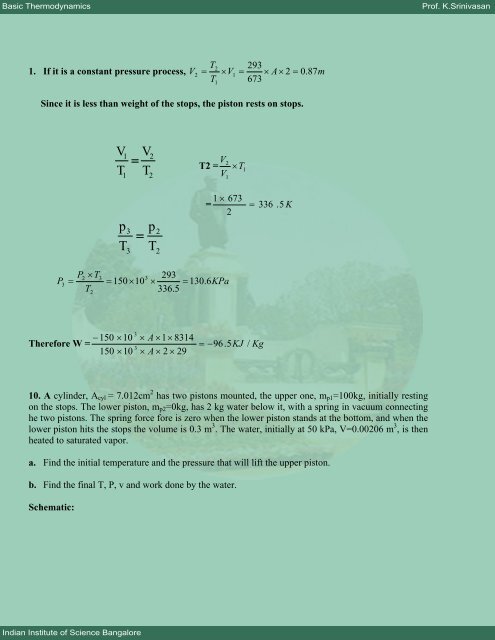Problems and Solutions - E-Courses
Problems and Solutions - E-Courses
Problems and Solutions - E-Courses
You also want an ePaper? Increase the reach of your titles
YUMPU automatically turns print PDFs into web optimized ePapers that Google loves.
Basic Thermodynamics Prof. K.Srinivasan<br />
T2<br />
293<br />
1. If it is a constant pressure process, V2 = × V1<br />
= × A×<br />
2 = 0.<br />
87m<br />
T 673<br />
Since it is less than weight of the stops, the piston rests on stops.<br />
Indian Institute of Science Bangalore<br />
T T<br />
V 1 V2<br />
= V2<br />
T2 = T1<br />
1<br />
p<br />
T<br />
3<br />
3<br />
2<br />
p<br />
=<br />
T<br />
2<br />
2<br />
1<br />
V ×<br />
P2<br />
× T3<br />
3 293<br />
P3 = = 150 × 10 × = 130.<br />
6KPa<br />
T<br />
336.<br />
5<br />
2<br />
1<br />
1 × 673<br />
= = 336 . 5 K<br />
2<br />
3<br />
− 150 × 10 × A × 1×<br />
8314<br />
Therefore W = = −96.<br />
5KJ<br />
/ Kg<br />
3<br />
150 × 10 × A × 2 × 29<br />
10. A cylinder, Acyl = 7.012cm 2 has two pistons mounted, the upper one, mp1=100kg, initially resting<br />
on the stops. The lower piston, mp2=0kg, has 2 kg water below it, with a spring in vacuum connecting<br />
he two pistons. The spring force fore is zero when the lower piston st<strong>and</strong>s at the bottom, <strong>and</strong> when the<br />
lower piston hits the stops the volume is 0.3 m 3 . The water, initially at 50 kPa, V=0.00206 m 3 , is then<br />
heated to saturated vapor.<br />
a. Find the initial temperature <strong>and</strong> the pressure that will lift the upper piston.<br />
b. Find the final T, P, v <strong>and</strong> work done by the water.<br />
Schematic:

















